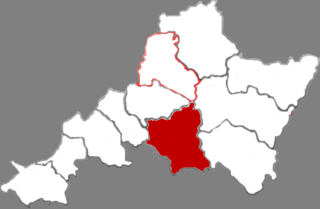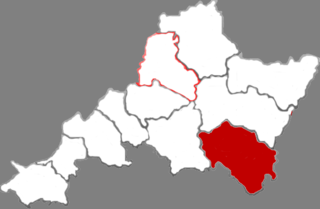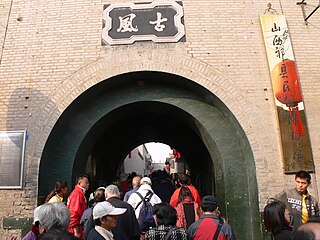Related Research Articles
Jinzhong College (晋中学院) is a college in Shanxi, China under the authority of the provincial government. It is on Wenyuan Road in Yuci district. It has several campuses. It was formerly established as a junior college level normal school in 1958 during The Great Leap Forward.

Jinzhong, formerly Yuci, is a prefecture-level city in east central Shanxi province of the People's Republic of China, bordering Hebei province to the east. As of the 2020 census, its total population was 3,379,498 inhabitants whom 1,226,617 lived in the Yuci and Taigu urban districts. However,5,433,659 lived in the built-up area of Taiyuan - Jinzhong made of Yuci district plus the 6 Taiyuan urban districts, largely conurbated.
Taiyuan No. 3 Prison is a prison in Nancheng District in Shanxi province of China. It is connected to a gas compressor factory. It was founded in 1952.

Lüliang or Lyuliang is a prefecture-level city in the west of Shanxi province, People's Republic of China, bordering Shaanxi province across the Yellow River to the west, Jinzhong and the provincial capital of Taiyuan to the east, Linfen to the south, and Xinzhou to the north. It has a total area of 21,143 square kilometres (8,163 sq mi) and total population of 3,398,431 inhabitants according to the 2020 Chinese census, of whom 456,355 lived in the built-up area made of Lishi District

Yuci District is a district in Jinzhong, Shanxi, China.
Changning may refer to:

The Qiao Family Compound, originally the Zaizhong Hall and officially Qiao's Grand Courtyard, is a courtyard house located in Qi County, Jinzhong Prefecture, Shanxi Province, China, approximately 30 kilometers (20 mi) northeast of Pingyao. It is the residential compound of well-known financier Qiao Zhiyong, who was the most famous member of the Qiao family. Construction began in 1756 during the reign of the Qianlong Emperor in the Qing dynasty and was completed sometime in the 18th century. The estate covers 9000 square meters and has 313 rooms with 4000 square meters within 6 large courtyards and 19 smaller courtyards.

Yushe County is a county in the east of Shanxi province, China. It is under the administration of the prefecture-level city of Jinzhong. Cao Shui, a famous poet, novelist, screenwriter, was born here. It is a predominantly rural county.

Zuoquan County is a county in the east of Shanxi Province of China, bordering Hebei Province to the east. It is under the administration of the prefecture-level city of Jinzhong.
Heshun County is a county of east-central Shanxi province, China. It is under the administration of Jinzhong City.

Xiyang County is a county in the east of Shanxi province, China, bordering Shanxi province to the east. It is the easternmost county-level division of the prefecture-level city of Jinzhong.

Shouyang County is a county in the east-central part of Shanxi province, China. It is under the administration of Jinzhong city.-

Taigu is a district of Shanxi province, China under the administration of Jinzhong City. It is administratively into three town-level entities, and six township-level entities. Taigu is linked to nearby Yuci in Jinzhong by rail via the Taigu Railway Stop.

Qi County, also known by its Chinese name Qixian, is a county in the central part of Shanxi Province, China. It is under the administration of the prefecture-level city of Jinzhong and has a population of approximately 265,310.

Lingshi County is a county of southwest-central Shanxi province, China. It is under the administration of Jinzhong city.

Wanrong County is a county under the administration of Yuncheng City, in the southwest of Shanxi Province, China, bordering Shaanxi province to the west.
Shen Weichen is a former Chinese politician from Shanxi province. During his career he served as the Communist Party Secretary of the city of Jinzhong in Shanxi province, the director of propaganda of Shanxi province, and the Party Secretary of Taiyuan, the provincial capital. In September 2010 Shen was transferred to work for the Central Propaganda Department of the Communist Party under Liu Yunshan.
Zhang Xiuping is a former Chinese politician from Shanxi province. Between 2013 and 2014 she served as the deputy party chief of Jinzhong, a prefecture-level city in Shanxi. In August 2014, she was put under investigation by the Communist Party's anti-corruption agency, then she was removed from office and expelled from the party in November 2014.

Jinzhong railway station is a railway station on the Datong–Xi'an high-speed railway and the Taiyuan–Jiaozuo high-speed railway that is located in Jinzhong, Shanxi, China. It started operation on July 1, 2014, together with the Railway.
References
Archived 2012-02-28 at the Wayback Machine